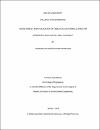Development and Evaluation of Fibrous Fluid Formulations for Horizontal Gas and Oil Well Cleanout
| المرشد | Nasser, Mustafa S. |
| المرشد | Hussein, Ibnelwaleed A. |
| المؤلف | MAHMOUD, HUSAMELDIN ABDELHAMID |
| تاريخ الإتاحة | 2021-02-17T09:14:50Z |
| تاريخ النشر | 2021-01 |
| الملخص | Cuttings substantial buildup on the downside of the wellbore is a challenging problem that encounters oil and gas drilling operations. Field reports indicate that inefficient hole cleaning increases the nonproductive time (NPT) by 30 percent. Good cuttings transportation within the wellbore is essential for efficient drilling operations. Inadequate hole cleaning can jeopardize the drilling process and lead to many problems, including reduced penetration rate, increased torque, bit wearing, and lost circulation. The addition of fiber enhances the cleaning properties of the drilling sweep with minor changes in the fluid rheology. However, maintaining stable uniform dispersion is essential to enable fibers' functionality for the intended purposes, which is challenging under wellbore harsh conditions. Furthermore, surface charge type and density (anionicity) of base polymers used in drilling fluids can contribute to the improvement of cutting suspension and hole cleaning properties. Therefore, the development of stable Fibrous Cleanout Fluids (FCFs) using different anionic polymeric formulations provide bases for efficient utilization of these materials toward successful hole cleaning. As a result, the main aim of this thesis is to provide fundamentals for cuttings, fiber, and polymer interactions, focusing on the development of stable fibrous water-based fluids for horizontal and vertical drilling hole cleaning applications. This thesis starts with an intensive literature review on different types of drilling fluids, experimentally tested and utilized in the drilling field; also, the vast majority of hole cleaning parameters are reported (Chapter 2). Following the materials and methods (Chapter 3), the results and discussion (Chapter 4) are split into two sections. The first part (Section 4.1) examines the influence of fibers concentration and aspect ratio, base polymer concentration, and solution temperature on FCFs stability; Fibers of higher aspect ratio showed better stability properties for FCF; formation of fiber's structured network decreases the fiber's sensitivity to destabilization under various conditions. The second part (Section 4.2) explored the impact of different base polymers anionicity and fibers addition on fine cuttings suspension and transportation. Zeta potential readings incorporated with total suspended solids (TSS) spectrometric measurements have highlighted the electrokinetic role in cuttings suspension. Solutions with high anionicity exhibit higher TSS concentrations. Particle-particle and particle-polymer electrostatic repulsive forces create a situation that prevents the settling of fine particles and preserves their suspension. Fiber addition improves the base fluid carrying capacity due to physical and hydrodynamic interfaces. Structured networks are formed in the medium of drilling fluid by fiber-fiber networking. Subsequently, the fiber network intercepts the trajectory of free-falling particles (cuttings); this fiber-particle interaction merges particle into the bulk of the network as a plug, which moves upward or remains suspended due to the fiber network high bouncy. Overall, the application of polyanionic polymer and fibers for hole cleaning application shall provide an environmentally friendly alternative to toxic oil-based muds. Outcomes of this thesis include one published article and two under review manuscripts. |
| اللغة | en |
| الموضوع | Water-based drilling fluid Hole cleaning Fibers Electrokinetic Fine cuttings transportation Suspension |
| النوع | Master Thesis |
| التخصص | Environmental Engineering |
الملفات في هذه التسجيلة
هذه التسجيلة تظهر في المجموعات التالية
-
الهندسة البيئية [52 items ]


